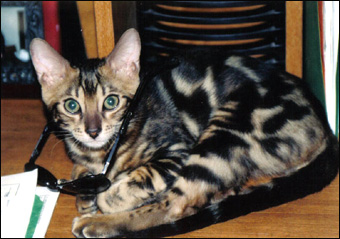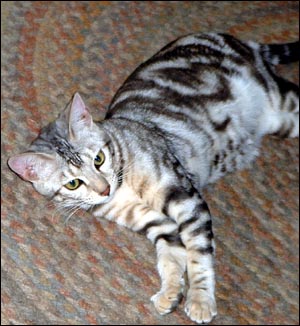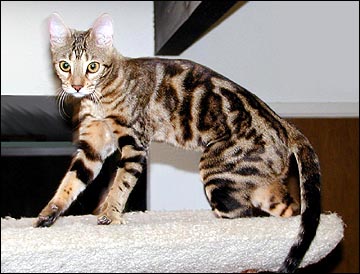
Foothill Felines King Ramses of Crazy Bengals at 5 months
(Photo of this dapper boy by owner Theresa Tolly)

Foothill Felines King Ramses of Crazy Bengals at 5 months
(Photo of this dapper boy by owner Theresa Tolly)
WHERE DO MARBLE BENGALS COME FROM?
It's easy to see why it can be confusing when one thinks about the beautiful marbled Bengal. If Bengal breeders are breeding to preserve as much as possible the physical beauty and traits of the wild Asian leopard cat Bengal ancestor, (see our article entitled, "What's a Bengal?), then how can there be a division within T.I.C.A. and other major cat associations recognizing the Bengal, for a marbled pattern Bengal cat?? Since there are no naturally occurring marbled Asian leopard cats, the marble gene had to have come from some or one of the domestic cats originally used in the early days of envisioning and creating the Bengal breed.
Foothill Felines Cosmo at 5 months (Photo by owner, Sharon Rogers)
According to various articles written by Jean Mill, the very first marbled Bengal appeared in 1987. The parents were Millwood Silk n Cinders (a beautiful cat who had the glitter gene from "Tory of Delhi", Jean's rescue domestic kitten from the New Delhi zoo, plus Cinders also had an unusually clear, non-ticked coat, with very large, dark spots) and a cat named Torchbearer. This first marble kitten was a female, and her coloring was very soft and rust-colored, with a pattern described by Jean as looking like "drizzled caramel".
One of Vida Mia's striking marble sons;
he had the white outline of a butterfly on the top of his head!It was due to the overwhelming popular demand of cat show judges and audiences clamoring to see this amazing marble kitten in Madison Square Garden and all over the country that Jean Mill began campaigning to add the marbled pattern to the Bengal breed standard. Originally, her intent had only been to produce a domestic spotted Bengal cat. As anyone who has ever seen a spectacular marble Bengal will attest, these cats will truly take your breath away. Not only are they beautiful, but they have been proven over and over again to contribute to such wonderful and difficult to breed genetic traits of the Bengal as the "outlining" gene, beautiful multi-colored types of rosetting to the spots, and having a horizontal flow (attributed to the Asian leopard cat) to the overall pattern of the cat, rather than the vertical flow common to traditional domestic cats.
Foothill Felines marble Bengal kitten showing beautiful pattern at 7 weeks
How do you know when you have a top quality marble Bengal?? It seems that each generation of marble Bengals just keeps getting better. Most associations that have a Bengal breed standard do give preference to marbles that have three or more shades; i.e., background color, the marble markings, and another color outlining the markings. These marbled Bengals are often referred to as "Tri-Colored Marbles". Some marbles are now exhibiting a "chaining" effect, which is truly spectacular. All top quality marbles should have a strong horizontal flow to their patterns, with as little influence from the domestic tabby as possible. Although the marble pattern itself is derived from the Bengal's domestic ancestors, the appearance of the pattern of top Bengal marbles needs to be strongly influenced by the wild Asian leopard cat's genepool, which means the horizontal flow which is especially evident when the cat is stretched. There will also be an overall random appearance of the markings, and there will be little or no circular "bulls-eye" markings or vertical spots on the body running together forming a mackerel tabby pattern. As with the spotted Bengals, the very best marble Bengals will have extremely sharp contrast and definition in their markings, with distinct shapes and sharp edges. (Look at the unique marble Bengal female below bred by Foothill Felines - she has actual spots appearing within her beautiful tri-colored marble pattern!) All marble Bengals must have spotted bellies.
Foothill Felines Likita of Fire'n'Ice Bengals (foreground; showing unique
spotting within her marbling pattern! Photo by owner, Wanda McDonald)Here is a little more background information and detail about the marble pattern in the Bengal cat, which is genetically referred to as a tabby. The majority of cats actually have what is referred to as "ticked" fur, rather than fur which is all a solid color, and in the majority of cases, the ticked fur alternates with solid color fur in a pattern, which is called "tabbying". "Ticking" itself is the result of the agouti gene (A) which causes the individual hairs of a cat to have bands of light and heavy pigmentation. This agouti gene allows full pigmentation when the hair starts to grow, then regulates the synthesis of pigment as the hair grows by slowing down the synthesis of pigment, then speeding it up again. As each hair approaches its normal length and stops growing, pigment synthesis also stops. The result is a hair shaft that has dense pigment at the tip, then a band of yellow to orange, then a band of dense pigment, usually fading to yellow to orange at the root.

Foothill Felines Silver Bell of Simply Simes Bengals at 6 months old
(Photo of this sweet silver marble female by owners Beth Bearry and Lori Simes)In eumelanistically-pigmented hair shafts, the agouti hair band is usually a dull yellow-beige color. However, breeders have been able to "warm up" the background colors of ticked tabbies by using the effect of "rufousing". These are polygenetic factors which breeders have been able to select for, but that have not yet been isolated and identified. You can see the effects of rufousing particularly in the Brown Tabby patterns, which are genetically Black, but by careful selection of individuals with strong rufousing, breeders have produced a rich orangish-gold brown color in the ticked hairs. Bengal breeders in particular are striving to achieve clearer coats with less ticking in both the marbled and spotted patterns. The mutation that causes solid color is called non-agouti (a/a), and is recessive to the agouti gene which causes ticking. The effect of non-agouti is to suppress the ticking, so the same density of pigment is found all along the hair shaft (except at the hair root, where the pigment normally begins to fade).
Foothill Felines Mobi (Photo by Mobi's owner, Ed Kerr)
The tabby pattern is determined by the tabby gene (T), which causes the ticked hairs to alternate with stripes, blotches, or spots of hairs of solid color. The commonly recognized types of tabby patterns have been given descriptive names:
1.) Mackerel Tabby. Ticked hairs alternate with solid hairs in stripes, as on a tiger. This is the most common tabby pattern.
2.) Classic Tabby. Ticked hairs alternate with solid hairs in a blotched pattern, often with a circular "bullseye" on the side, or a "butterfly" on the back. (This is called a Blotched Tabby in the United Kingdom.)
3.) Ticked Tabby. Ticked hairs are found uniformly over the entire coat, giving a flecked or freckled appearance. (This pattern is sometimes called the Agouti Tabby or Abyssinian Tabby.)
4.) Spotted Tabby. Ticked hairs alternate with spots or rosettes of solid color, as on a leopard or jaguar.

Double Champion Foothill Felines Manzanita at 1 year
FOOTHILL FELINES BENGALS & SAVANNAHS
P.O. Box 418104, Sacramento, CA 95841-8104, U.S.A.
(916) 481-CATS Phone/Fax; E-mail: holly@hdw-inc.com
© 1996-2008 Copyright
by HDW Enterprises, Inc. - All Rights Reserved. 
HDW Enterprises,
Inc., P.O. Box 418104, Sacramento, CA 95841-8104 (916) 481-CATS ph/fax
http://www.hdw-inc.com e-mail: holly@hdw-inc.com